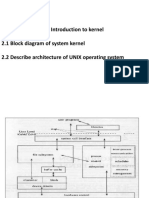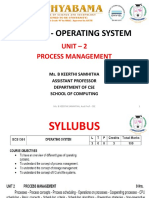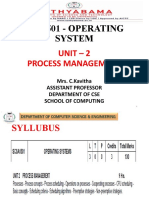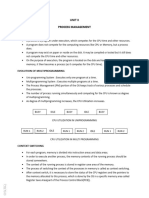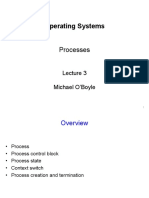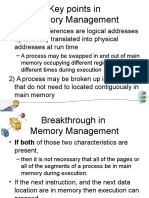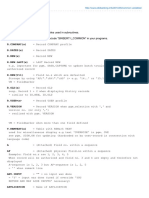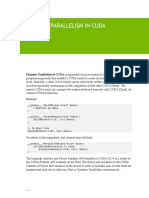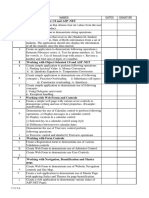Unit No: 2
Process & Threads
Prepared by: OSD Group,
Dept of Computer, VIIT
�1. To understand process & thread concepts & their
working in Linux environment
2. To know significance of context of process
3. To understand deadlock and to simulate it with
real time examples
4. To understand working of init process on Android
device
OSD, TE Computer, VIIT
�After the completion of the unit, students
should be able
1. To design the process scheduler for UNIX
like environment
2. To manage IPC using IPC constructs
3. To create single and multi-threaded process
4. To
implement Ostrich and Banker's
algorithm for deadlock avoidance
5. To demonstrate working of init process on
Android device
OSD, TE Computer, VIIT
Process and its management
Shell script
Thread management
Deadlock
Init process in Android
OSD, TE Computer, VIIT
Structure of process
Process states and transition
Context of process
Data structures of process
Components of context of process
Process creation, termination
Signals
OSD, TE Computer, VIIT
A program in execution
An instance of a program running on a
computer
The entity that can be assigned to and
executed on a processor
A unit of activity characterized by the
execution of a sequence of instructions, a
current state, and an associated set of system
instructions
OSD, TE Computer, VIIT
A process is comprised of:
Program code (possibly shared)
A set of data
A number of attributes describing the state of the
process
OSD, TE Computer, VIIT
While the process is running it has a number
of elements including
Identifier
State
Priority
Program counter
Memory pointers
Context data
I/O status information
Accounting information
OSD, TE Computer, VIIT
Contains
the
process
elements
Created and manage by
the operating system
Allows
support
for
multiple processes
OSD, TE Computer, VIIT
Process may be in one of two states
Running
Not-running
OSD, TE Computer, VIIT
10
�Etc processes moved by the dispatcher of the OS to the CPU then
back to the queue until the task is competed
OSD, TE Computer, VIIT
11
�Creation
New batch job
Interactive Login
Created by OS to
provide a service
Spawned by
existing process
Termination
Normal Completion
Memory
unavailable
Protection error
Operator or OS
Intervention
OSD, TE Computer, VIIT
12
The OS builds a data structure to manage the
process
Traditionally, the OS created all processes
But it can be useful to let a running process create
another
This action is called process spawning
Parent Process is the original, creating, process
Child Process is the new process
OSD, TE Computer, VIIT
13
There must be some way that a process can
indicate completion.
This indication may be:
A HALT instruction generating an interrupt alert to
the OS.
A user action (e.g. log off, quitting an application)
A fault or error
Parent process terminating
OSD, TE Computer, VIIT
14
�OSD, TE Computer, VIIT
15
�User Running
interrupt,
interrupt return
4
Asleep
in
Memory
sleep
swap
out
Sleep, Swapped
reschedule
process
Ready to
Run in Memory
enough mem
Created
swap
out
wakeup
Preempted
Kernel
Running
preempt
wakeup
return
to user
return
Zombie
system call,
interrupt
swap
in
fork
not enough mem
(swapping system only)
Ready to Run, Swapped
OSD, TE Computer, VIIT
16
Executing in user mode
Executing in kernel mode
Not executing but is ready to run as soon as kernel
schedules it
Process is sleeping and resides in main memory
Process is ready to run but swapper must swap it in
main memory before kernel schedules it for
execution
Process is sleeping and swapped in to secondary
mem.
Process is returning from kernel mode to user mode
, but kernel preempts it
Process is newly created and is in a transition state
Process executed exit system call and is in zombie
state.
OSD, TE Computer, VIIT
17
�Kernel Process
Table
Kernel Region
Table
A Process
Per Process Region Table
Text
File Descriptor Table
Data
Stack
U Area
OSD, TE Computer, VIIT
18
Kernel Process table
describes state of every active process
Contains general fields of processes that must
be always be accessible to the kernel
U area
contains additional information that controls
operation of a process
further characteristics of the process only need
to be accessible to the running process itself
OSD, TE Computer, VIIT
19
�per process
region table
Kernel region table
u area
Kernel
process table
main memory
OSD, TE Computer, VIIT
20
State field: user running, kernel running
etc
Fields that allow the kernel to locate the
process and u area. Requires while context
switch
Process size : kernel know how much
space to allocate for the process
User ID
Process ID : specify relationship between
processes
OSD, TE Computer, VIIT
21
Event descriptor
Used when the process is in the "sleep" state.
Scheduling parameters
Allow the kernel to determine the order in
which processes move to the states "kernel
running" and "user running
A signal field
keeps the signals sent to a process but not
yet handled
Various
timers:
process
resource utilization etc
execution
OSD, TE Computer, VIIT
time,
22
A pointer to the process table entry
User IDs
various Timer:
Execution time in user mode
Execution Time in kernel mode
An error field: keeps error during system
call
Return value field: result of system call
OSD, TE Computer, VIIT
23
I/O parameters
Amount of data transfer
Address of source and target etc.
The current directory and current root
User file descriptor table : records the files the
process has open
Limit fields
Restrict process size
Restrict size of the file it can write
The control terminal field:
login terminal associated with the process, if one exists
An array indicates how the process wishes to
react to signal
OSD, TE Computer, VIIT
24
System has 3 logical sections : text, data
and stack
A region is contiguous area of virtual
address space of process that can be
treated as shared or protected
Kernel region table contains the pointer to
the page table which keeps the physical
memory address
OSD, TE Computer, VIIT
25
Each process contains private per process
region table
Can be found in process table/u area
Each pregion entry points to the kernel
region table
Starting virtual (absolute) address of the
region
Permission filed:
read-only, read-write, read-execute
OSD, TE Computer, VIIT
26
�Region
Per Proc Region Tables
(Virtual Addresses)
Process
A
Text
8K
Data 16K
Stack32K
a
Text
4K
Process
Data 8K
B
Stack
32K
<Processes and Regions>
OSD, TE Computer, VIIT
27
Every mem location = (page no., byte
offset in page)
32 bit addr : 22 bit page no + 10 bit offset
Logical Page Number
0
1
2
3
Physical Page Number
177
54
209
17
OSD, TE Computer, VIIT
28
�Per Proc Region Table
Page Tables(Physical Addresses)
Text
8K
empty
Data 32K
137K
Stack 64K
852K
87K
764K
541K
552K
433K
783K
727K
333K
986K
941K
897K
1096K
Virtual Addresses
.
.
.
.
.
.
.
.
2001K
.
.
.
.
.
.
.
.
.
.
.
.
.
.
.
.
<Mapping Virtual Addresses to Physical Address>
OSD, TE Computer, VIIT
29
Size of page is 1K bytes, process wants to
access 68432.
It accesses page 2, and offset 986K
OSD, TE Computer, VIIT
30
Virtual mem. Mapping for kernel is
independent.
The code and data of kernel resides in
system permanently
The kernel page tables are similar to
process PT
Kernel addr. Space 0 to 4M-1
User addr. Space = 4M up
Two sets of mem mgmt triplets : kernel
(kenel mode) and user (user mode)
OSD, TE Computer, VIIT
31
�OSD, TE Computer, VIIT
32
Every process has private u area but still
kernel has access to it
The virtual address to u area is assigned at
OS compilation time
Concern module knows the addr.
OSD, TE Computer, VIIT
33
�OSD, TE Computer, VIIT
34
Consists of contents of user level,reg. level
and system level
Reg. level context
PC
PSW
SP
General purpose reg.
OSD, TE Computer, VIIT
35
System level :
Static part
State of the process from PT
Dynamic part
OSD, TE Computer, VIIT
36
�OSD, TE Computer, VIIT
37
Interrupts and exceptions
If CPU is at lower level than int. level it accepts it
It saves the current reg. context and creates new
layer
Determines source of int. , gets int. no.
Refers IVT
Kernel invokes int. handler
IRET , restores previous context layer
Refer dia.
OSD, TE Computer, VIIT
38
User level context is static part
Region table entry contains
a ptr to inode of the file whose contents loaded
into region
Region type
Location of region in physical mem.
Status of region : locked, in demand, in the
process
Valid
Ref. count
OSD, TE Computer, VIIT
39
Kernel allocates a new region during
fork,exec,shmget sys calls
Kernel has a region table whose entry will
be either on free list or active list
Upload dia.
OSD, TE Computer, VIIT
40
Kernel attaches a newly allocated or
existing shared region
Process should not exceed the system limit
of highest VA.
OSD, TE Computer, VIIT
41
No longer attached region is returned to
list of free region.
If region is associated with inode kernel
releases the inode.
Kernel releases the physical resources e.g
page table, pages
OSD, TE Computer, VIIT
42
Fork call execution
Allocates a slot in the process table
Assigns a unique ID no
It makes a logical copy of context of parent
Increments file and inode table counters
Returns ID to parent and 0 to child
OSD, TE Computer, VIIT
43
Occurrence of asynchronous events.
19 signals in system V
Can be classified as
Termination of process
Signals for process induced exceptions
Unrecoverable conditions during sys call
execution
Signals caused by unexpected error conditions
e.g writing a pipe that has no reader , illegal
ref. in lseek etc
Signals originated from process in UM e.g.
alarm
Related to terminal interaction
Tracing execution of process
OSD, TE Computer, VIIT
44
Shell basics
Shell types
First shell script
Logic : if
Logic : for
Logic : while
OSD, TE Computer, VIIT
45
�INPUT
shell
OUTPUT
ERROR
OSD, TE Computer, VIIT
46
Any Program
But there are a few popular shells
OSD, TE Computer, VIIT
47
/bin/sh
/bin/bash
Bourne-Again Shell
OSD, TE Computer, VIIT
48
C Shell (/bin/csh)
Turbo C Shell (/bin/tcsh)
Korn Shell (/bin/ksh)
OSD, TE Computer, VIIT
49
C Shell (/bin/csh)
Turbo C Shell (/bin/tcsh)
Korn Shell (/bin/ksh)
OSD, TE Computer, VIIT
50
/bin, /usr/bin, /usr/local/bin
/sbin, /usr/sbin, /usr/local/sbin
/tmp
/dev
/home/borwicjh
OSD, TE Computer, VIIT
51
A Text File
With Instructions
Executable
OSD, TE Computer, VIIT
52
�% cat > hello.sh
#!/bin/sh
echo Hello, world
% chmod +x hello.sh
% ./hello.sh
Hello, world
OSD, TE Computer, VIIT
53
% ./hello.sh
echo vs. /usr/bin/echo
% echo $PATH
/bin:/usr/bin:/usr/local/bin:
/home/borwicjh/bin
% which echo
/usr/bin/echo
OSD, TE Computer, VIIT
54
�% hello.sh
bash: hello.sh: Command not found
% PATH=$PATH:.
% hello.sh
Hello, world
OSD, TE Computer, VIIT
55
�% echo $USER
$USER
% echo $USER
borwicjh
% echo \
% echo deacnet\\sct
deacnet\sct
% echo \
\
OSD, TE Computer, VIIT
56
�OSD, TE Computer, VIIT
57
�% echo This \
Is \
A \
Very \
Long \
Command Line
This Is A Very Long Command Line
%
OSD, TE Computer, VIIT
58
$?
0 is True
% ls /does/not/exist
% echo $?
1
% echo $?
0
OSD, TE Computer, VIIT
59
�% cat > test.sh
exit 3
% chmod +x test.sh
% ./test.sh
% echo $?
3
OSD, TE Computer, VIIT
60
�%
%
0
%
%
1
test 1 -lt 10
echo $?
test 1 == 10
echo $?
OSD, TE Computer, VIIT
61
�% echo $(( 1 + 2 ))
3
% echo $(( 2 * 3 ))
6
% echo $(( 1 / 3 ))
0
OSD, TE Computer, VIIT
62
�if [ $USER eq borwicjh ]
then
:
# elif a contraction of else if:
elif ls /etc/oratab
then
:
else
then
:
fi
OSD, TE Computer, VIIT
63
�# see if a file exists
if [ /etc/passwd ]
then
echo /etc/passwd exists
else
echo /etc/passwd not found!
fi
OSD, TE Computer, VIIT
64
�for i in 1 2 3
do
echo $i
done
OSD, TE Computer, VIIT
65
�for i in /*
do
echo Listing $i:
ls -l $i
read
done
OSD, TE Computer, VIIT
66
�a=0; LIMIT=10
while [ "$a" -lt "$LIMIT" ]
do
echo -n "$a
a=$(( a + 1 ))
done
OSD, TE Computer, VIIT
67
�#!/bin/bash
echo "enter maximum number
read n
# taking input from user
echo "enter Numbers in array:
for (( i = 0; i < $n; i++ ))
do
read nos[$i]
done
#printing the number before sorting
echo "Numbers in an array are:
for (( i = 0; i < $n; i++ ))
do
echo ${nos[$i]}
done
OSD, TE Computer, VIIT
68
�# Now do the Sorting of numbers
for (( i = 0; i < $n ; i++ ))
do
for (( j = $i; j < $n; j++ ))
do
if [ ${nos[$i]} -gt ${nos[$j]} ]; then
t=${nos[$i]}
nos[$i]=${nos[$j]}
nos[$j]=$t
fi
done
done
OSD, TE Computer, VIIT
69
�# Printing the sorted number
echo -e "\nSorted Numbers
for (( i=0; i < $n; i++ ))
do
echo ${nos[$i]}
done
OUTPUT:
pavan@pavan-desktop:~$bash BubbleSort.sh
enter maximum number
4
enter numbers in array:
4
1
0
3
OSD, TE Computer, VIIT
70
�Numbers in an array are:
4
1
0
3
Sorted Numbers in Ascending Order:
0
1
3
4
pavan@pavan-desktop:~$
OSD, TE Computer, VIIT
71
Concepts
Various threading models
Fork() & exec() system call
Thread library
Thread cancellation
Thread specific data
OSD, TE Computer, VIIT
72
A basic unit of CPU utilization. It comprises a thread ID, a program counter, a
register set, and a stack. It is a single sequential flow of control within a
program
It shares with other threads belonging to the same process its code section,
data section, and other OS resources, such as open files and signals
A traditional (or heavyweight) process has a single thread of control
If a process has multiple threads of control, it can perform more than one
task at a time. Threads are a way for a program to split itself into two or
more simultaneously running tasks. That is the real excitement surrounding
threads
OSD, TE Computer, VIIT
73
�OSD, TE Computer, VIIT
74
� A word processor may have a threads for
displaying graphics
responding to keystrokes from the user
performing spelling and grammar checking in the
background
OSD, TE Computer, VIIT
75
�OSD, TE Computer, VIIT
76
Imagine the following C program
main() {
ComputePI(pi.txt);
PrintClassList(clist.text);
}
What is the behaviour here?
OSD, TE Computer, VIIT
77
Version of program with Threads
main() {
CreateThread(ComputePI(pi.txt));
CreateThread(PrintClassList(clist.text));
}
What does CreateThread do?
Start independent thread running given procedure
What is the behavior here?
This should behave as if there are two separate CPUs
CPU1
CPU2
CPU1
CPU2
CPU1
CPU2
Time
OSD, TE Computer, VIIT
78
If we stopped this program and examined it
with a debugger, we would see
Two sets of CPU registers
Stack 1
Two sets of Stacks
Heap
Address Space
Stack 2
Global Data
Code
OSD, TE Computer, VIIT
79
Each Thread has a Thread Control Block (TCB)
Execution State: CPU registers, program counter, pointer to
stack
Scheduling info: State (more later), priority, CPU time
Accounting Info
Various Pointers (for implementing scheduling queues)
Pointer to enclosing process (PCB)
Etc
OSD, TE Computer, VIIT
80
Responsiveness
Resource Sharing
Economy
Utilization of MP Architectures
OSD, TE Computer, VIIT
81
Support for threads may be provided either at the
user level, for user threads (supported above the
kernel and managed without kernel support), or by
the kernel, for kernel threads (supported and
managed directly by the OS)
Three common ways of establishing relationship
between user and kernel threads
Many-to-One
One-to-One
Many-to-Many
OSD, TE Computer, VIIT
82
Thread management done by user-level threads
library
Three primary thread libraries
POSIX Pthreads
Win32 threads
Java threads
OSD, TE Computer, VIIT
83
Supported by the Kernel
Examples
Windows XP/2000
Solaris
Linux
Tru64 UNIX
Mac OS X
OSD, TE Computer, VIIT
84
Many user-level threads mapped to single kernel
thread
OSD, TE Computer, VIIT
85
Basically, the kernel is not aware of the existence
of threads.
Thread switching does not require kernel mode
privileges and scheduling is application specific.
Thread management is done by the thread library
in user space, so it is efficient
Just as a uniprocessor provides the illusion of
parallelism by multiplexing multiple processes on a
single CPU, user-level threads packages provide
the illusion of parallelism by multiplexing multiple
user threads on a single kernel thread
OSD, TE Computer, VIIT
86
Since there is only one kernel thread, if a user
thread executes a blocking system call, the entire
process blocks, since no other user thread can
execute until the kernel thread (which is blocked in
the system call) becomes available
Multithreaded programs will run no faster on
multiprocessors than they run on uniprocessors.
The single kernel thread acts as a bottleneck,
preventing optimal use of the multiprocessor
OSD, TE Computer, VIIT
87
Advantages
Thread switching does not involve kernel no mode switching
Scheduling
algorithm
can
be
application
specific
choose
best
ULTs can run on any OS only needs a thread library
Disadvantages
Most system calls are blocking and the kernel blocks processes
all threads within the process will be blocked
Kernel can only assign processes to processors threads
within same process cannot run simultaneously on processors
OSD, TE Computer, VIIT
88
Each user-level thread maps to kernel thread
OSD, TE Computer, VIIT
89
Because each kernel thread is actually a different kernelschedulable entity, multiple threads can run concurrently on
different processors
Can achieve significant speedups
uniprocessors to multiprocessors
when
migrated
from
Unlike the many-to-one model, threads blocking in the
kernel do not impede process progress under the one-to-one
model.
The only drawback is that creating a user thread requires
creating the corresponding kernel thread
Overhead of creating kernel threads can burden the performance
of the application
OSD, TE Computer, VIIT
90
Allows many user-level threads to be mapped to many
kernel threads
Idea is to combine the best of both approaches
OSD, TE Computer, VIIT
91
A thread library provides the programmer with an
API for creating and managing threads
Two primary ways of implementing a thread library
Provide the library entirely in user space with no kernel
support.
Implement kernel-level library supported directly by the OS.
Three main thread libraries in use today: (1) POSIX
Pthreads, (2) Win32, and (3) Java
OSD, TE Computer, VIIT
92
Example: Design a multithreaded program
that performs the following summation in a
separate thread
sum =
i=0
OSD, TE Computer, VIIT
93
�#include <pthread.h>
#include <stdio.h>
int sum; //this data is shared by the thread(s)
void *runner(void *param); // the thread
main(int argc, char* argv[])
{
pthread_t tid; // the thread identifier
pthread_create(&tid,NULL,runner,argv[1]); // create thread
pthread_join(tid,NULL); // now wait for the thread to exit
printf("sum = %d\n",sum);
}
OSD, TE Computer, VIIT
94
�void *runner(void *param) {
int upper = atoi(param);
int i;
sum = 0;
if (upper > 0) {
for (i = 1; i <= upper; i++)
sum += i;
}
pthread_exit(0);
}
OSD, TE Computer, VIIT
95
�Semantics of fork() and exec() system calls
Thread cancellation of target thread
Asynchronous or deferred
Signal handling
Thread pools
Thread-specific data
Scheduler activations
OSD, TE Computer, VIIT
96
Terminating a thread before it has finished
Two general approaches:
Asynchronous cancellation terminates the target
thread immediately
Deferred cancellation allows the target thread to
periodically check if it should be cancelled
OSD, TE Computer, VIIT
97
If one thread in a program calls fork(), does the
new process duplicate only the calling thread or all
threads?
Some UNIX systems provide two versions of fork()
One duplicates all threads
The other duplicates only the thread that invoked fork()
If a thread invokes exec(), the program specified
in the parameter to exec() will replace the entire
process including all threads
OSD, TE Computer, VIIT
98
Signals are used in UNIX systems to notify a
process that a particular event has occurred
A signal handler is used to process signals
1. Signal is generated by particular event
2. Signal is delivered to a process
3. Signal is handled
Options:
Deliver the signal to the thread to which the signal
applies
Deliver the signal to every thread in the process
Deliver the signal to certain threads in the process
Assign a specific thread to receive all signals for the
process
OSD, TE Computer, VIIT
99
Create a number of threads in a pool where
they await work
Advantages:
Usually slightly faster to service a request with an
existing thread than create a new thread
Allows the number of threads in the application(s) to
be bound to the size of the pool
OSD, TE Computer, VIIT
10
0
Allows each thread to have its own copy of
data
Useful when you do not have control over
the thread creation process (i.e., when
using a thread pool)
OSD, TE Computer, VIIT
10
1
�OSD, TE Computer, VIIT
10
2
Linux refers to them as tasks rather than
threads
Thread creation is done through clone()
system call
clone() allows a child task to share the
address space of the parent task (process)
OSD, TE Computer, VIIT
10
3
Concepts
Principles of deadlock
Deadlock strategies
Prevention
Avoidance
Detection
Recovery
Ostrich algorithm
Bankers algorithm
OSD, TE Computer, VIIT
10
4
A set of processes is deadlocked when each
process in the set is blocked awaiting an
event that can only be triggered by another
blocked process in the set
Typically involves processes competing for the
same set of resources
No efficient solution
OSD, TE Computer, VIIT
10
5
�I need
quad C
and B
I need
quad B
and C
I need
quad A
and B
I need
quad D
and A
OSD, TE Computer, VIIT
10
6
�HALT until
D is free
HALT until
C is free
HALT until
B is free
HALT until
A is free
OSD, TE Computer, VIIT
10
7
�OSD, TE Computer, VIIT
10
8
Lets look at this with
two processes P and Q
Each needing exclusive
access to a resource A
and B for a period of
time
OSD, TE Computer, VIIT
10
9
Consider a pair of processes, in which each
process attempts to receive a message from
the other process and then send a message
to the other process
OSD, TE Computer, VIIT
11
0
�OSD, TE Computer, VIIT
11
1
Devise a ritual (algorithm) that will allow the
philosophers to eat.
No two philosophers can use the same fork at the
same time (mutual exclusion)
No philosopher must starve to death (avoid
deadlock and starvation literally!)
OSD, TE Computer, VIIT
11
2
�OSD, TE Computer, VIIT
11
3
�OSD, TE Computer, VIIT
11
4
Directed graph that depicts a state of the
system of resources and processes
OSD, TE Computer, VIIT
11
5
Mutual exclusion (non-sharable resources)
Only one process may use a resource at a time
Hold-and-wait
A process may hold allocated resources while
awaiting assignment of others
No pre-emption
No resource can be forcibly removed from a
process holding it
OSD, TE Computer, VIIT
11
6
�All previous 3 conditions plus:
Circular wait
A closed chain of processes exists, such that each
process holds at least one resource needed by the
next process in the chain
OSD, TE Computer, VIIT
11
7
�OSD, TE Computer, VIIT
11
8
�OSD, TE Computer, VIIT
11
9
Three general approaches exist for dealing
with deadlock.
Prevent deadlock
Avoid deadlock
Detect Deadlock
OSD, TE Computer, VIIT
12
0
Design a system in such a way that the
possibility of deadlock is excluded.
Two main methods
Indirect prevent one of the three necessary
conditions from occurring
Direct prevent circular waits
OSD, TE Computer, VIIT
12
1
Mutual Exclusion
Hold and Wait
No Preemption
Circular Wait
Must be supported by the OS
Require a process request all of its required
resources at one time
Process must release resource and request again
OS may preempt a process to require it releases
its resources
Define a linear ordering of resource types
OSD, TE Computer, VIIT
12
2
It is a strategy of ignoring potential problems on
the basis that they may be exceedingly rare
It is named for the ostrich effect, i.e. to stick
ones head in the sand and pretend there is no
problem
This assumes that it is more cost effective to
allow problem to occur than to attempt its
prevention
UNIX and Windows takes this approach.
It is trade-off between convenience &
correctness
OSD, TE Computer, VIIT
12
3
A decision is made dynamically whether the
current resource allocation request will, if
granted, potentially lead to a deadlock
Requires knowledge of future process
requests
OSD, TE Computer, VIIT
12
4
Process Initiation Denial
Do not start a process if its demands might lead to
deadlock
Resource Allocation Denial
Do not grant an incremental resource request to a
process if this allocation might lead to deadlock
OSD, TE Computer, VIIT
12
5
A process is only started if the maximum
claim of all current processes plus those of
the new process can be met.
Not optimal,
Assumes the worst: that all processes will make
their maximum claims together.
OSD, TE Computer, VIIT
12
6
Referred to as the bankers algorithm
A strategy of resource allocation denial
Consider a system with fixed number of
resources
State of the system is the current allocation of
resources to process
Safe state is where there is at least one sequence
that does not result in deadlock
Unsafe state is a state that is not safe
OSD, TE Computer, VIIT
12
7
When a process makes a request for a set of
resources,
assume that the request is granted,
Update the system state accordingly,
Then, determine if the result is a safe state.
If so, grant the request
if not, block the process until it is safe to grant the
request.
OSD, TE Computer, VIIT
12
8
�OSD, TE Computer, VIIT
12
9
�OSD, TE Computer, VIIT
13
0
�OSD, TE Computer, VIIT
13
1
�OSD, TE Computer, VIIT
13
2
Maximum resource requirement must be
stated in advance
Processes under consideration must be
independent and with no synchronization
requirements
There must be a fixed number of resources to
allocate
No process may exit while holding resources
OSD, TE Computer, VIIT
13
3
Deadlock prevention
conservative;
strategies
are
very
limit access to resources and impose restrictions on
processes.
Deadlock detection strategies do the opposite
Resource requests are granted whenever possible.
Regularly check for deadlock
OSD, TE Computer, VIIT
13
4
Abort all deadlocked processes
Back up each deadlocked process to some
previously defined checkpoint, and restart all
process
Risk or deadlock recurring
Successively abort deadlocked processes until
deadlock no longer exists
Successively
preempt
resources
until
deadlock no longer exists
OSD, TE Computer, VIIT
13
5
�OSD, TE Computer, VIIT
13
6
About Android
Android boot process / sequence
OSD, TE Computer, VIIT
137
It is Linux-based open source operating
system
All android devices runs on ARM (Advanced
RISC Machine) process, except Intels Xolo
device
Android boot sequence has minor difference
compare to desktop version
Next slide explain boot sequence of Android
device
OSD, TE Computer, VIIT
13
8
�OSD, TE Computer, VIIT
13
9
Step 1 : power on and system start up
When power start Boot ROM code start execution
from pre defined location which is hardwired on
ROM
It load Bootloader into RAM and start execution
Step 2 : bootloader
Bootloader is small program which runs before
Android operating system running
Popular bootloader - redboot, uboot, qi bootloader
Android bootloader can be found at - <Android
Source>\bootable\bootloader\legacy\usbloader
OSD, TE Computer, VIIT
14
0
Step 3 : kernel
Android kernel start similar as desktop Linux kernel
starts
When kernel finish system setup, it first look for
init in file system
Step 4 : init process
It is very first process.
Treated as ancestor of all processes
It
is
can
be
found
at
source>/system/core/init
And
init.rc
at
source>/system/core/rootdir/init.rc
OSD, TE Computer, VIIT
<android
<android
14
1
Step 5 : Zygote and Dalvik
Zygote enable shared code across Dalvik VM, lower
memory footprint and minimal startup time
Zygote is a VM process that starts at system boot
Zygote preloads and initialize core library classes
Step 6 : system service
After completion of above steps, system servers are
started
System servers are considered as process, which is
written in native and Java both
OSD, TE Computer, VIIT
14
2
�1.
Explain five state process model with diagram
2.
Explain with examples, process scheduling algorithms:
FSFC, Priority, SJF, RR
3.
Compare above process scheduling algorithms
4.
Explain with diagram saving context of process
5.
Is operating system itself a process? Justify your answer.
6.
Compare and contrast process with thread.
7.
Explain with suitable diagram multi-threading models.
OSD, TE Computer, VIIT
14
3
�8. Write short notes on popular thread library (For eg, POSIX, Java, Win32)
9. What do you understand by deadlock? How deadlock can be prevented?
10. What do you understand by deadlock? How deadlock can be avoided?
11. What do you understand by deadlock? How deadlock can be detected?
12. Is deadlock prevention is better than deadlock avoidance ? Justify your
answer
13. Explain with example Banker algorithm
14. Write notes on ostrich algorithm
15. Explain in details six steps of Android boot process
OSD, TE Computer, VIIT
14
4
�[1] William Stalling, Operating Systems: Internals and Design
Principles, 6/E, Prentice Hall
[2] Maurice J. Bach, The Design of UNIX Operating System, PHI,
ISBN 978-81-203-0516-8
[3]
www.wfu.edu/~borwicjh/presentations/UNIX
Shell-Scripting
Basics.ppt
[4] cse.stfx.ca/~mlin/cs375/lectures/thread.ppt
[5]
http://www.kpbird.com/2012/11/in-depth-android-boot-sequence-
process.html
OSD, TE Computer, VIIT
14
5
�Thank You
OSD, TE Computer, VIIT
14
6





